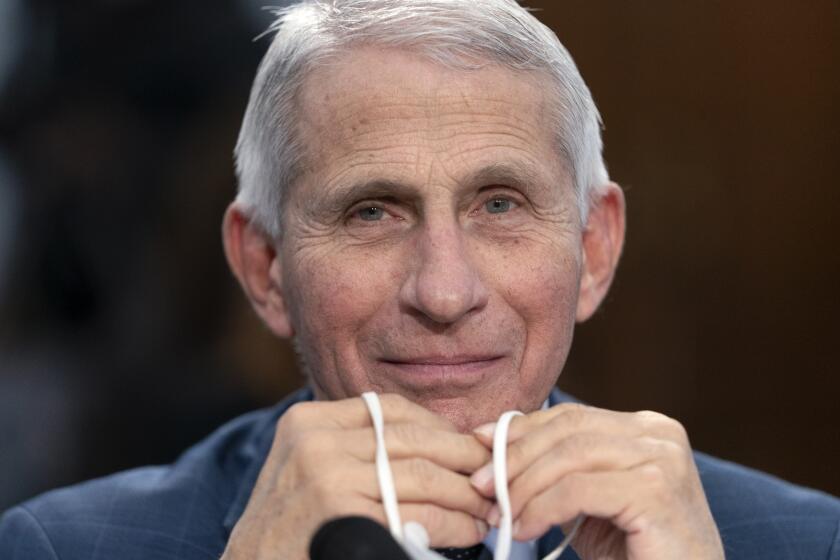COLUMN ONE : Cold War’s End Brings Enemy Gap : For decades, opposition to the Red Menace has bound a fractious nation in common purpose. With that guiding principle gone, how will the U.S. define its mission?
Harry Angstrom always had a healthy contempt for the Russians, spurned leftist politics and backed President Lyndon B. Johnson all the way when L.B.J. took on the Reds in Vietnam.
But it was with vexation and regret--even nostalgia--that the Everyman hero of John Updike’s celebrated “Rabbit” novels watched the death throes of communist governments in Poland, the Soviet Union and East Germany on the flickering light of his TV screen.
“I miss it, the Cold War,” an aging Rabbit laments in “Rabbit at Rest,” the 1990 novel that is the final work of Updike’s series. “It gave you a reason to get up in the morning.”
The average Americans that Angstrom typified are still watching the brick-by-brick dismantling of the communist edifice--and, like him, many are a little unsettled by what it means for them. For 46 years, they have derived their national purpose and defined their place in the world in terms of opposition to communism. And now that that hostile ideology is ebbing, many find themselves unsure about America’s mission and identity.
With the Red Menace gone, what--if anything--will the nation stand up for?
The Cold War, so inaptly named, left 112,000 dead Americans in Korea and Vietnam. It entangled the nation in Nicaragua, Afghanistan and other distant lands, roused it to McCarthyite witch hunts at home and brought on nuclear-age neurosis, burdensome defense budgets and the Cuban missile crisis.
But it also provided America with a guiding principle that bound a heterogeneous, often-fractious nation together in common purpose.
We were Democracy. We were Freedom. We were what they were not.
Now that history has smudged the great dividing line of our age, “we’re like a rope-pull team that has just seen the other squad totally disappear,” says Todd Gitlin, a sociologist at UC Berkeley. “The rope’s hanging in the air. . . . We’re having a crisis of enemies.”
To the extent that history is ever in human hands, we can choose our future: Will this country now find substitute enemies in regional despots such as Iraqi President Saddam Hussein, or in economic rivals, such as the Japanese? Will communism’s decline bring a new isolationism? Will it, coming at a time of rising immigration, contribute to a splintering of the United States into antagonistic ethnic and interest groups?
Or will Americans, unburdened of old fears, rally to the kind of higher purpose that psychologist William James called “the moral equivalent of war,” and attack the problems of poverty, education, health care and pollution with the uncompromising determination that marked our exertions against communism?
Enemies often serve to bind nations. From the time of the Bolshevik Revolution, the masters of the Kremlin used the threat of imperialist encirclement to prod their people to greater sacrifice. Hitler trumpeted the menace of enemies abroad and Jews at home to mobilize Germans to work harder and pay more for his diabolical purpose.
“War taxes are the only ones men never hesitate to pay,” James wrote in his 1910 essay, in which he described societies’ need to summon in peacetime the energy, inventiveness and sacrifice their citizens so often display in war.
And foreign adversaries have always been particularly valuable for the United States: As a young country, it was not cemented by long centuries of history, or even by a unique language. It was a nation of nationalities, searching for a destiny.
For much of the 20th Century, the Cold War filled the bill. Our self-definition as the alternative to communism “was a solution on the cheap to our identity crisis,” says Gitlin. “It lasted us half a century.”
Not that there was anything artificial about U.S. concern. Even as the ruins of the Nazi empire smoldered, Stalin’s Soviet Union expanded the borders of the Russian empire across Eastern Europe and imposed totalitarian regimes as ruthless and brutal as Hitler’s had been. Avowedly expansionist, communists seized power in North Korea, led the revolution in China and boasted of their designs on the rest of Asia, Africa--and the Americas.
The Soviets waged a war of terror on their countrymen and erected nuclear weapons capable of striking anywhere in the world.
Many Americans were frightened and repelled, including many who did not fully accept the overheated rhetoric of FBI Director J. Edgar Hoover:
“Communism is a way of life--an evil and malignant way of life. It reveals a condition akin to disease that spreads like an epidemic, and like an epidemic, a quarantine is necessary to keep it from infecting the nation.”
In service of that quarantine, America remobilized in 1947 for a Cold War that quickly reshaped the nation’s politics, its economy and its culture.
After cutting defense spending to about 2% of its gross national product after V-J Day, the country lifted it again to more than 10% through the early 1950s. Barricades bristling with high-technology weapons were flung up across Europe and Asia, and even at home.
With only brief interruptions, America had always been an isolationist nation. But for nearly 50 years now it has been the world’s sentry.
“We established NATO, a panoply of other alliances and a worldwide network of military bases,” Ted Sorenson, the former John F. Kennedy aide, wrote in Foreign Affairs magazine last year. “We fought in Korea and then in Vietnam, first isolated then wooed China, imposed sanctions on Cuba, subverted governments in Guatemala and Chile, subsidized rebellions in Angola and Nicaragua, suppressed rebellions in the Dominican Republic and Grenada, (and) placed our flag on the moon . . . all in the name of outbidding, outmaneuvering or outlasting Soviet-sponsored communism.”
The rearmament gave rise to a vast new defense industry, creating scores of new companies, drawing others into defense work. It was the government, remember, that put an office machines outfit named IBM into the computer business with a 1949 contract to build air defenses.
The issue of how to fight the Red Menace transformed politics as well. Now it was the most important issue in presidential elections, according to some. “By whatever name--the Cold War, containment, defense spending--it became the central, dividing issue in presidential politics,” says Joshua Muravchik, resident scholar at the American Enterprise Institute.
The Cold War was responsible for one of the ugliest periods of American politics: the Redbaiting of the late 1940s and 1950s. The anti-communist fever burned so hot that FBI Director Hoover, a presidential appointee, could go before the House Un-American Activities Committee in March, 1947, to denounce President Harry S. Truman for being soft on the Reds that Hoover and many others saw behind every potted plant.
Hollywood producers and directors tattled on the man or woman in the next office to keep themselves in a job. The FBI formulated elaborate plans for jailing communist sympathizers in emergencies, and the government sealed the borders to Red-tainted aliens--including a Canadian trade unionist who had once belonged to a Little League team organized by communists.
In this atmosphere, an obscure California congressman named Richard M. Nixon rose to prominence. Ex-State Department official Alger Hiss fell. Julius and Ethel Rosenberg, convicted of passing atom bomb secrets to the Soviet Union, were electrocuted.
The fever of those years passed, but its effects on American politics lingered. Once and for all, it frightened American liberals and organized labor from their dalliance with communism.
It reshaped national policy debates by making mainstream politicians allergic to ideas that could be attacked as too left-leaning. For years, a range of European-style social ideas--from national health care to wider labor rights--went friendless in the public forum.
And perhaps most profound of all, nuclear rivalry delivered us to an age of anxiety. The experts described the bomb neurosis as a mild but chronic feeling of powerlessness, an anxiety about the future--and whether there would be one.
A few psychologists saw more: In children’s dreams of nuclear doomsday, they found evidence of deeper psychic wounds.
The age of the bomb cast its blackest shadow in the Cold War’s early years, when schoolchildren practiced duck-and-cover drills at school, and magazines solemnly discussed the morality of barring the bomb shelter door to the next-door neighbors in a missile attack.
We learned about the Strategic Air Command, Ground Zero, the half-life of plutonium, and wondered whether we wanted our own lives to continue after the bomb.
The Cold War suffused American culture, high and low. The struggle left a legacy of cultural totems: the Mushroom Cloud, the Button, the Hot Line. And a lexicon that long ago began to sound quaint: the Missile Gap, the Space Race, the Iron Curtain. The Evil Empire. Peaceniks. Pinkos.
It brought us “On the Beach,” “The Manchurian Candidate,” “Dr. Strangelove,” “Red Dawn,” “Hiroshima” and “The Fate of the Earth.”
It produced a wax museum of heroes, mock-heroes and anti-heroes: James Bond, Rambo and Dr. Strangelove’s Gen. Jack D. Ripper, John le Carre’s George Smiley, the spymaster, and Alec Leamas, the agent who came in from the cold.
The Cold War’s dualistic Manichaean vision has insinuated itself into our fantasies, as in the black-white world of J.R.R. Tolkien’s “Lord of the Rings.”
But if aspects of the crusade seem quixotic through our rearview mirror, its rallying cry was irresistible for a host of national undertakings. If the Cold War seemed to require it, we would do almost anything. Some of the things we did even had peaceful benefits.
Dwight D. Eisenhower wanted to build an interstate highway system and helped ensure popular support by arguing that the roads were needed to evacuate cities threatened by nuclear fireballs.
President Kennedy cited the value of research when he stepped up the space race, although everybody knew that the government’s other concern--Soviet space shots--was the compelling motive.
Kennedy used the global ideological competition to argue the need for better science education, physical fitness for schoolchildren, even more civil rights for minorities.
Today, many experts argue that despite the technological payoff from the arms race--in communications equipment, computers and aerospace gear--the effort was in fact a gaping wound on the American economy that bought precious time for our once-supine trade rivals.
But if the American economy might have been better off without a nuclear-studded adversary, Americans’ sense of national purpose might not. Perhaps that is part of the reason Americans have seemed so slow to abandon their longstanding fear of the old communist foe.
In polls, people remain sharply divided on whether the rivalry with the Soviet Union is over, though more and more seem to see the Soviets as friendly to this country.
Americans’ focus seems to be shifting from one bad guy to another. Gitlin, the sociologist, notes that polls have shown rapid fluctuations in what problem Americans believe to pose the gravest danger to the republic.
In October, 1986, the single largest group of respondents to a CBS-New York Times survey said drugs were “the most important problem facing us.” A year later, drugs had plunged to sixth place--after unemployment, the economy, the deficit, foreign affairs and nuclear war.
“It’s amazing the alacrity with which we’re lurching between enemies,” Gitlin says. He believes Americans are eager to be rallied to a cause, as they demonstrated with their support for the war against an Iraqi tyrant who until recently was so obscure.
“On Aug. 1, 1990, Saddam Hussein was an evil figure nobody had heard of,” Gitlin says. “On the second of August he was the man everybody loved to hate.”
Modern communications and travel may also make it less likely that a new and credible villain will emerge. In the age of the mobile minicam, we may see too clearly that the enemy is too similar to ourselves to believe that he could be a demon.
“The question these days is, can anybody create a credible external threat when you can see the guy face to face?” asks Francisco Sagasti, the World Bank’s leading Soviet analyst.
To many, the Japanese pose the greatest threat to our national well-being. But their inadequacies as an enemy have long been apparent; it is hard to unite behind a tough trade policy if it results in jacking up the price of a Toyota or a digital audiotape player.
Next year, Europeans will form a huge trading bloc that some Americans see as a menace. But “Europe ‘92” seems unlikely to replace “Evil Empire” as a battle cry.
“It’s hard to get people very excited without a military threat,” says Gaddis Smith, a diplomatic historian at Yale. “Politicians just can’t do much with purely economic competition.”
And if no new foe emerges?
The unraveling of the Soviet empire is expected to take several years, and in that time American attitudes will probably persist. Then, some analysts worry, the country could adopt as its guiding foreign policy principle the Yankee isolationism that has been a national reflex for most of its history.
“For 40 years, many Americans believe, we put up with complaining allies, poured money into ungrateful or undemocratic governments, opened our markets to disagreeable competitors . . . all to win friends against the Soviet empire and to keep others out of the Soviet orbit,” writes Sorenson. “Now there is no Soviet orbit, no enemy, no more reason to get involved.”
Analysts such as Gitlin speculate that there may be no single principle that galvanizes the American public. Instead, a variety of “moral entrepreneurs”--abortion foes, environmental advocates, anti-poverty stalwarts--will vie for allegiance as America’s first cause.
And Gitlin sees a danger in the absence of a uniting identity at a time when the country seems to be demographically splintering, and when disadvantaged groups seem to be increasingly battling over scarce public resources.
But others hold out hope that the end of the Cold War will actually allow us to begin a period of great domestic renewal, to become the shining “city on a hill” of Pilgrim John Winthrop’s oratory.
Martin Sherwin, contemporary historian at Tufts University, notes that the great periods of domestic reform--the New Deal, the Progressive era and the Jacksonian years--came at times when America faced no immediate threat from abroad.
“We have a political free market, and I believe that people with a very different message will emerge and lead us to solve these problems,” he says. “I don’t see them on the horizon. But I’ve got to have faith they’ll be there.”
Staff writer John M. Broder in Washington contributed to this story.
More to Read
Sign up for our Book Club newsletter
Get the latest news, events and more from the Los Angeles Times Book Club, and help us get L.A. reading and talking.
You may occasionally receive promotional content from the Los Angeles Times.







